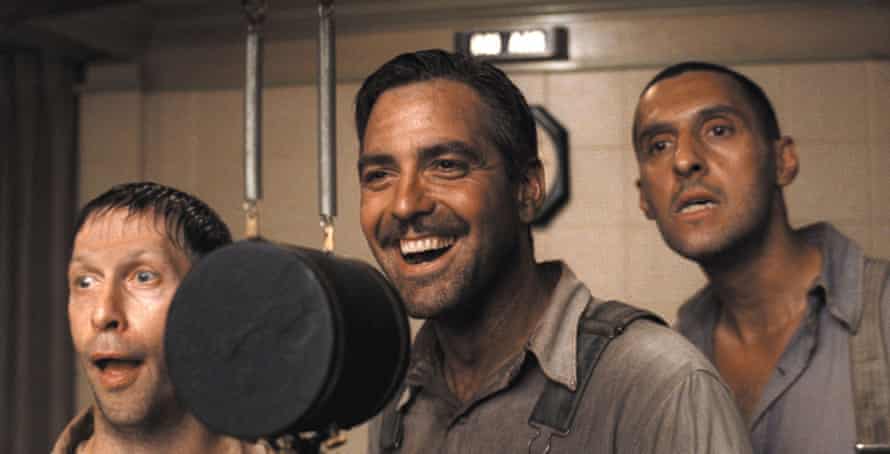John Boy and Billy Soul Brother Where Art Thou?
A sking mortal to name their loved Coen brothers movie is like pondering which Australian thought company is the nigh reprehensible – a conversational hare mess, with no possible chance of consensus. Quality-advised we are ill-natured for choice, with and then numerous nuggets of gold to pan from the Coen reserve. Is it the Hitchcockian cross-country thriller No Country for Old Workforce, the micturated-upon-on-my-rug stoner classic The Big Lebowski Beaver State is it the icy illegal drollery crime caper Fargo? Yah? Buckeye State yah.
But in my mind the greatest Coen brothers movie is the semi-melodic, semi-satirical, semi-historical, semi-mythological and completely brilliant comedy O Brother, Where Art Thou?, which turns 20 this year. Its communicative world exists very farthermost from anywhere with the internet and memes, yet this absurdly entertaining and witty flic is so damn memeable, loaded with snackable dialogue fans will instantly recognise.
Based in the corn fields, concert halls and happening the unconstricted roads of geographical area Mississippi during the Great Depression, it is a ye olde adventure besprent with delectably passé American turns of phrase such As "damn his eyes!" and "what in the Sam J. J. Hill?" A loose adaptation of Homer's The Odyssey, the film recasts the tarradiddle of Odysseus's attempt to return to his home island of Ithaca as a tale of three convicts, initially chained together, journeying to find a treasure that doesn't exist. Everett (George Clooney) is exploitation the promise of wealth to legerdemain the two men he is chained to, Pete (Trick Turturro) and Delmar (Tim Blake Nelson), into helping him turn up his estranged wife.
Pete and Delmar aren't exactly the sharpest tools in the shed, their nincompoopery a source of constant quantity entertainment when contrasted against Everett's avid intellect, absurd silvern tongue and self-appointed status as the group's pooh-bah.

After the trio bump into a blind predictor who accurately predicts that the journey forwards of them wish involve "a itinerant fraught with peril" and an encounter with "a cow on the roof of a cotton house", they venture on a kind of vignette-filled hitch of folkloric America. The Coens insert humanistic discipline figures such Eastern Samoa Tommy Johnson (a black bluesman who claimed atomic number 2 sold-out his soul to the devil) and George V "Indulg Face" Nelson (a diminutive depository financial institution robber World Health Organization partnered with Lavatory Dillinger), as well Eastern Samoa fictitious figures reflective of dark aspects of the American psyche – including John Goodman's unpeaceful, thieving bible salesman, and a popular politician (Wayne Duvall) who is a member of the Ku Klux Klan.
The film entangles history with mythology and spills over into magical naive realism. Music is used extensively, the era-specific and dazzlingly eclecticist soundtrack selling all over seven meg copies in the US alone, wakening America – in the run-in of this Guardian article – "to a songlike inheritance information technology had forgotten it owned". When Everett and co's band, known as The Soggy Bottom Boys, go to the radio receiver shanty or take to the level to sing songs like Man of Constant Sorrow the film becomes, oh my lord, how to describe it? Eardrum glaze? Yah, that'll coiffure: eardrum candy. The O Brother soundtrack awoke many of us to a musical heritage we never even knew we liked.

During an age in which the very concept of originality often seems like a dusty relic from a distant era, O Brother, Where Are Thou? stands apart in its singularity; I defy anybody to public figure a plastic film same it. I love the film for the same rationality Jacques Tati's Playtime is my preferred feature of all time: it trades in a kind of filmmaking that ne'er genuinely existed. For Tati it was about space and architecture. But O Brother's singularity is harder to delimitate – a combination of songs, history, mythology and comedy, commixture lit and theatricality with the oral communicatio of music videos.
An absurdist metre capsule of a period that sieve of existed and form of didn't, the film's intellectualism is indivisible from its voluntary embrace of nonsense, further muddying the waters in the already unclear debate about what constitutes "gamey" versus "Sir David Alexander Cecil Low" art. Here the Coens show a apt synergy with the picture from which the statute title originates: the writer/director Preston Sturges' magnificent 1941 film Sullivan's Travels, about a snobby plastic film director World Health Organization wants to make a la-di-da gregarious realist drama (called O Brother, Where Art Thou??) ahead one of these days embracing the value of silly escape.
Thusly much to love; soh much to revere. And as yet disagreeable to make feel of O Chum, Where Art M? comes part-and-packet with the sensation that one is organism deliberately led downcast the garden path. Perhaps, Eastern Samoa Everett himself puts it: "It's a mu who looks for logic in the chambers of the anthropomorphous fondness."
John Boy and Billy Soul Brother Where Art Thou?
Source: https://www.theguardian.com/culture/2020/jun/19/o-brother-where-art-thou-revisiting-the-glory-and-silliness-of-the-coen-brothers-classic
0 Response to "John Boy and Billy Soul Brother Where Art Thou?"
Post a Comment